Acamprosate in a mouse model of fragile X syndrome: modulation of spontaneous cortical activity, ERK1/2 activation, locomotor behavior, and anxiety
- PMID: 28616095
- PMCID: PMC5467053
- DOI: 10.1186/s11689-017-9184-y
Acamprosate in a mouse model of fragile X syndrome: modulation of spontaneous cortical activity, ERK1/2 activation, locomotor behavior, and anxiety
Abstract
Background: Fragile X Syndrome (FXS) occurs as a result of a silenced fragile X mental retardation 1 gene (FMR1) and subsequent loss of fragile X mental retardation protein (FMRP) expression. Loss of FMRP alters excitatory/inhibitory signaling balance, leading to increased neuronal hyperexcitability and altered behavior. Acamprosate (the calcium salt of N-acetylhomotaurinate), a drug FDA-approved for relapse prevention in the treatment of alcohol dependence in adults, is a novel agent with multiple mechanisms that may be beneficial for people with FXS. There are questions regarding the neuroactive effects of acamprosate and the significance of the molecule's calcium moiety. Therefore, the electrophysiological, cellular, molecular, and behavioral effects of acamprosate were assessed in the Fmr1-/y (knock out; KO) mouse model of FXS controlling for the calcium salt in several experiments.
Methods: Fmr1 KO mice and their wild-type (WT) littermates were utilized to assess acamprosate treatment on cortical UP state parameters, dendritic spine density, and seizure susceptibility. Brain extracellular-signal regulated kinase 1/2 (ERK1/2) activation was used to investigate this signaling molecule as a potential biomarker for treatment response. Additional adult mice were used to assess chronic acamprosate treatment and any potential effects of the calcium moiety using CaCl2 treatment on behavior and nuclear ERK1/2 activation.
Results: Acamprosate attenuated prolonged cortical UP state duration, decreased elevated ERK1/2 activation in brain tissue, and reduced nuclear ERK1/2 activation in the dentate gyrus in KO mice. Acamprosate treatment modified behavior in anxiety and locomotor tests in Fmr1 KO mice in which control-treated KO mice were shown to deviate from control-treated WT mice. Mice treated with CaCl2 were not different from saline-treated mice in the adult behavior battery or nuclear ERK1/2 activation.
Conclusions: These data indicate that acamprosate, and not calcium, improves function reminiscent of reduced anxiety-like behavior and hyperactivity in Fmr1 KO mice and that acamprosate attenuates select electrophysiological and molecular dysregulation that may play a role in the pathophysiology of FXS. Differences between control-treated KO and WT mice were not evident in a recognition memory test or in examination of acoustic startle response/prepulse inhibition which impeded conclusions from being made about the treatment effects of acamprosate in these instances.
Keywords: Anxiety; Dendritic spine density; Electrophysiology; Extracellular signal-related kinase; Fragile X syndrome; Hippocampus; Hyperactivity; Open field; Striatum.
Figures
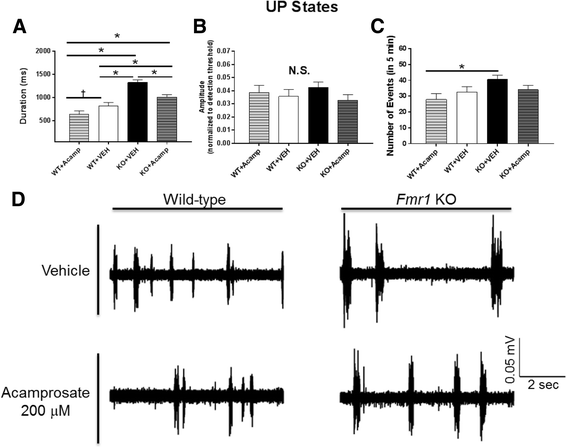
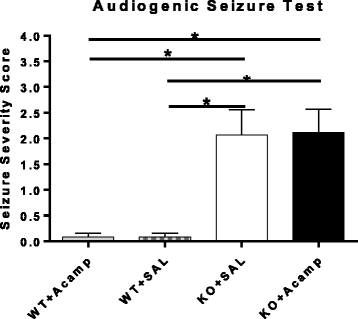
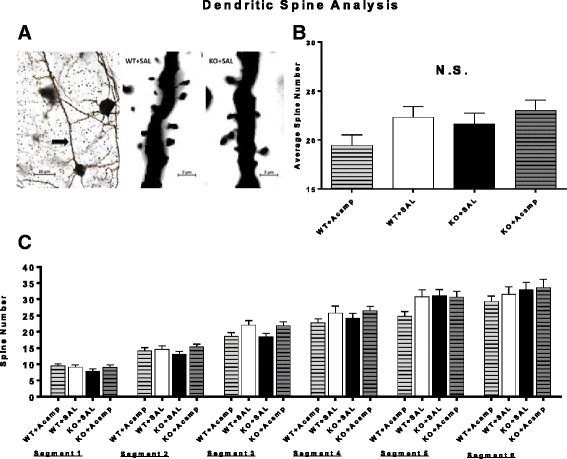
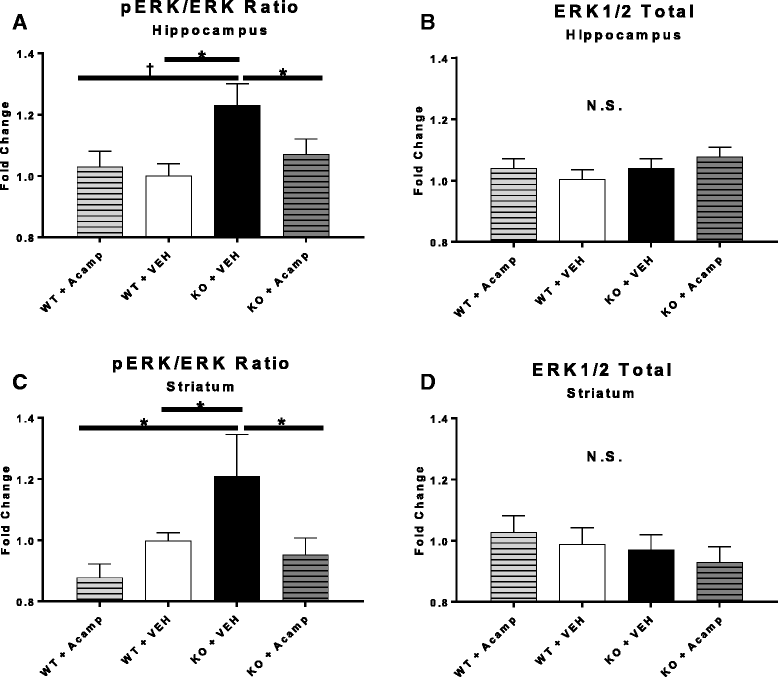
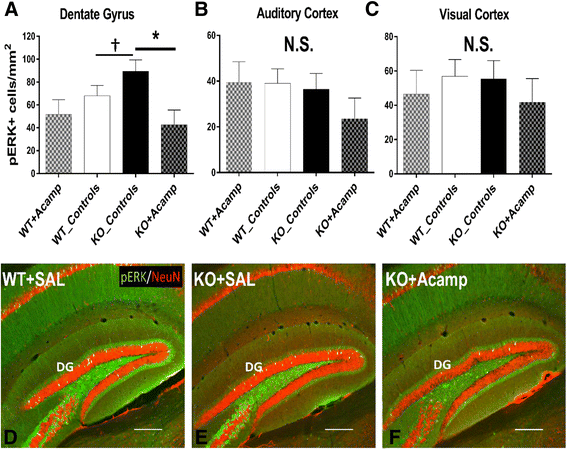
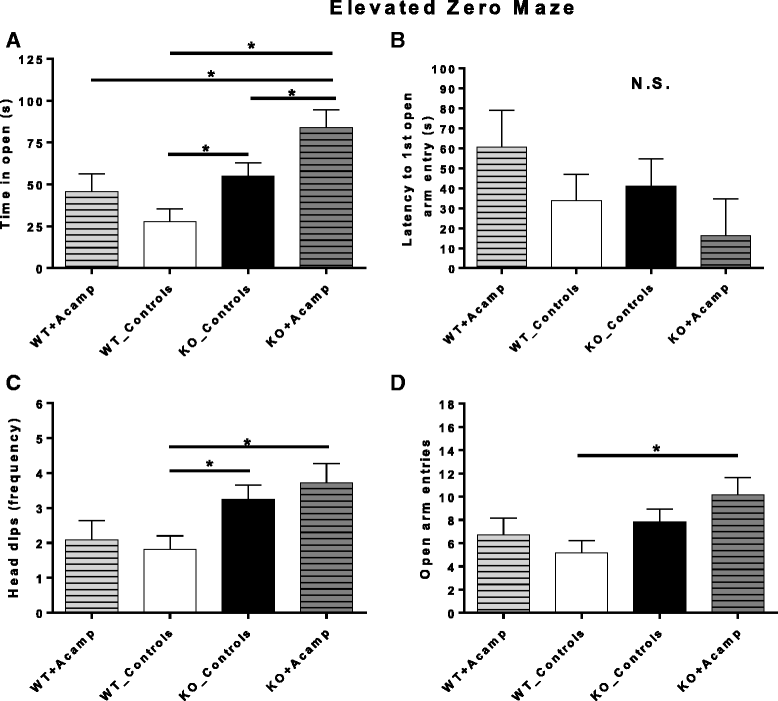
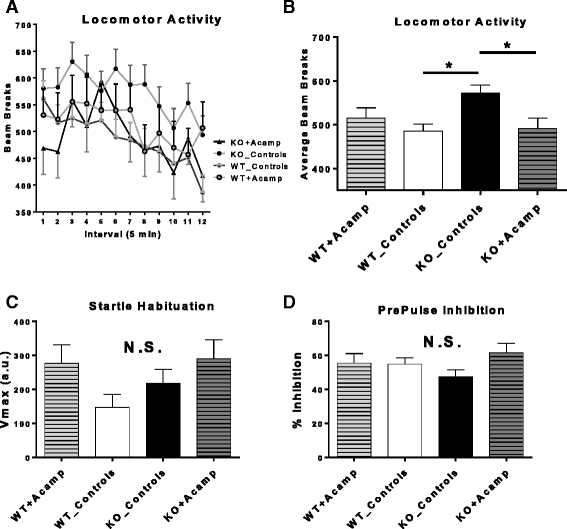
Similar articles
-
Exaggerated behavioral phenotypes in Fmr1/Fxr2 double knockout mice reveal a functional genetic interaction between Fragile X-related proteins.Hum Mol Genet. 2006 Jun 15;15(12):1984-94. doi: 10.1093/hmg/ddl121. Epub 2006 May 4. Hum Mol Genet. 2006. PMID: 16675531
-
Decreased surface expression of the δ subunit of the GABAA receptor contributes to reduced tonic inhibition in dentate granule cells in a mouse model of fragile X syndrome.Exp Neurol. 2017 Nov;297:168-178. doi: 10.1016/j.expneurol.2017.08.008. Epub 2017 Aug 16. Exp Neurol. 2017. PMID: 28822839 Free PMC article.
-
Matrix metalloproteinase-9 deletion rescues auditory evoked potential habituation deficit in a mouse model of Fragile X Syndrome.Neurobiol Dis. 2016 May;89:126-35. doi: 10.1016/j.nbd.2016.02.002. Epub 2016 Feb 2. Neurobiol Dis. 2016. PMID: 26850918 Free PMC article.
-
BDNF in fragile X syndrome.Neuropharmacology. 2014 Jan;76 Pt C:729-36. doi: 10.1016/j.neuropharm.2013.05.018. Epub 2013 May 29. Neuropharmacology. 2014. PMID: 23727436 Review.
-
Molecular and cellular aspects of mental retardation in the Fragile X syndrome: from gene mutation/s to spine dysmorphogenesis.Adv Exp Med Biol. 2012;970:517-51. doi: 10.1007/978-3-7091-0932-8_23. Adv Exp Med Biol. 2012. PMID: 22351071 Review.
Cited by
-
Efficient Delivery of FMR1 across the Blood Brain Barrier Using AAVphp Construct in Adult FMR1 KO Mice Suggests the Feasibility of Gene Therapy for Fragile X Syndrome.Genes (Basel). 2023 Feb 16;14(2):505. doi: 10.3390/genes14020505. Genes (Basel). 2023. PMID: 36833432 Free PMC article.
-
Molecular Biomarkers in Fragile X Syndrome.Brain Sci. 2019 Apr 27;9(5):96. doi: 10.3390/brainsci9050096. Brain Sci. 2019. PMID: 31035599 Free PMC article. Review.
-
Early Administration of the Phytocannabinoid Cannabidivarin Prevents the Neurobehavioral Abnormalities Associated with the Fmr1-KO Mouse Model of Fragile X Syndrome.Cells. 2023 Jul 25;12(15):1927. doi: 10.3390/cells12151927. Cells. 2023. PMID: 37566006 Free PMC article.
-
Multifarious Functions of the Fragile X Mental Retardation Protein.Trends Genet. 2017 Oct;33(10):703-714. doi: 10.1016/j.tig.2017.07.008. Epub 2017 Aug 18. Trends Genet. 2017. PMID: 28826631 Free PMC article. Review.
-
An experimentally validated approach to automated biological evidence generation in drug discovery using knowledge graphs.Nat Commun. 2024 Jul 8;15(1):5703. doi: 10.1038/s41467-024-50024-6. Nat Commun. 2024. PMID: 38977662 Free PMC article.
References
Grants and funding
LinkOut - more resources
Full Text Sources
Other Literature Sources
Research Materials
Miscellaneous

